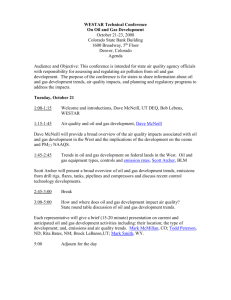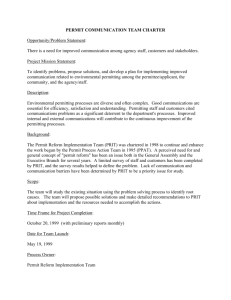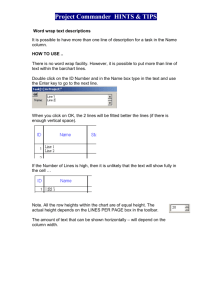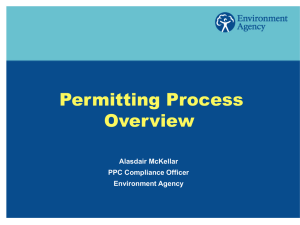EnvironmEntal PErmittinG
advertisement
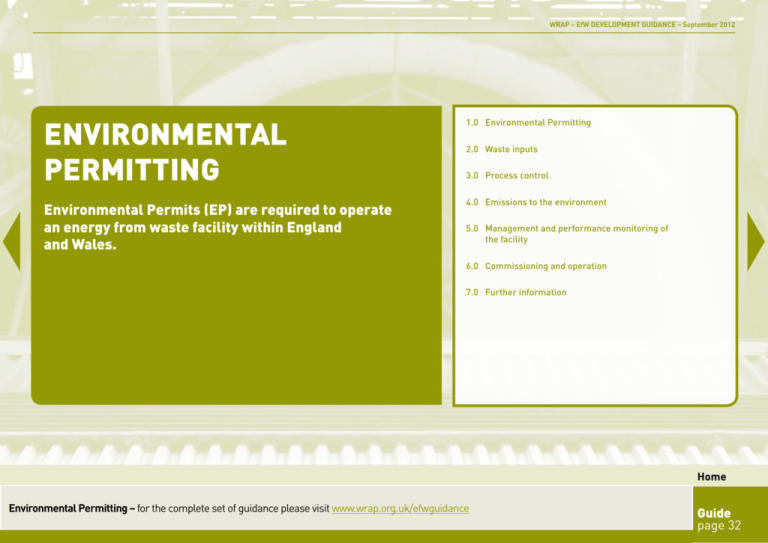
WRAP – EfW DEVELOPMENT GUIDANCE – September 2012 Environmental Permitting 1.0 Environmental Permitting Environmental Permits (EP) are required to operate an energy from waste facility within England and Wales. 4.0 Emissions to the environment 2.0 Waste inputs 3.0 Process control 5.0 M anagement and performance monitoring of the facility 6.0 Commissioning and operation 7.0 Further information Home Environmental Permitting – for the complete set of guidance please visit www.wrap.org.uk/efwguidance Guide page 32 WRAP – EfW DEVELOPMENT GUIDANCE – September 2012 1.0 Environmental Permitting Environmental Permits (EP) are required to operate an energy from waste (EfW) facility within England and Wales1. They are the overarching mechanism for regulating EfW facilities and are issued by the Environment Agency (EA) or the facility’s Local Authority (LA). The facility regulator, and therefore the issuing authority, will depend upon the scale of the proposed facility and where the activity sits within the confines of the Environmental Permitting (England and Wales) Regulations (EPR) 2010. Generally, facilities accepting waste as a fuel and with a capacity in excess of 1 tonne per hour will be regulated by the EA, and anything less than this by the LA. For consistency, the term Regulating Authority is used within this guidance note to mean both the EA and LA where relevant. If you are considering operating an EfW facility you will need to consult with the appropriate regulator on the scope and extent of the EP you will require. The appropriate regulator will require a considerable amount of information about the activity you are proposing to carry out in order to grant an EP. This guidance sets out some of that information and the process you must undergo to achieve one. The Regulating Authority requires a considerable amount of information about the activity you are proposing to carry out in order to grant an EP. For consistency, this document makes reference to ‘combustion’ and ‘combustion conditions’ when describing the process under which waste is thermally degraded, with or without the presence of oxygen, or to generate gases that are subsequently processed to generate energy. It is recognised that not all thermal treatment processes are combustion. However, to ensure consistency with Environment Agency Technical Guidance Notes, which also make the above distinction, combustion and combustion conditions are used when referencing the thermal breakdown of waste and the design conditions which lead to the thermal breakdown of such wastes. EPs are issued in Scotland exclusively by SEPA and in Northern Ireland by NIEA. Apply to the EA via http://www.environment-agency.gov.uk/business/topics/permitting/32318.aspx or contact your Local Authority. Fuel usage of over one tonne per hour will require an EA permit, less than 1 tonne per hour an LA permit. 1 2 1.1 What is an Environmental Permit ? An EP is a permit to operate a facility governed by the requirements of the Environmental Permitting (England and Wales) Regulations 2010 (EPR). The regulations cover a range of types of facilities including waste management facilities such as recycling and recovery facilities and EfW. The EPR were introduced into UK law within England and Wales in 2007 and combined the Pollution Prevention and Control Regulations and the Waste Management Licensing Regulations, thereby introducing one environmental regulation system that covers all aspects of environmental regulation. In 2010 the EPR were further updated to include water discharges and groundwater activities, radioactive substances and provisions for a number of other Directives such as the Mining Waste Directive. The principal aims of the EPR are to: bring Environmental Regulation across England and Wales onto a level playing field; provide protection for the environment by controlling and regulating pollution control and emissions to air, water and land; and emphasise the polluter pays mechanism by making operators liable for the condition of the land on which they operate. The EPR introduced a tiered approach to environmental regulation based on the potential risk to the environment of the proposed activities. Authorisations can be in the form of registered exemptions; standard rules EPs and bespoke EPs. Exemptions cover those activities at the lowest risk end of the spectrum while bespoke EPs will cover higher risk activities - see Section 7 for further information on permit levels. All EfW activities require an EP so operators will need to apply to the relevant Regulating Authority for an appropriate authorisation2. The permit will have conditions which must be followed to prevent business activities from harming the environment or human health. Home Environmental Permitting – for the complete set of guidance please visit www.wrap.org.uk/efwguidance Guide page 33 WRAP – EfW DEVELOPMENT GUIDANCE – September 2012 1.2 What are the Environmental Permitting (England and Wales) Regulations 2010? The EPR 2007 brought into force the first phase of the Environment Agency’s environmental permitting system and established a common permitting programme. The EPR 2010 brought into force the bulk of the second phase of environmental permitting and extended this common permitting system to cover a wider range of permitted activities and exemptions3. 1.3 Who needs an Environmental Permit? You must have an EP if your business carries out any activity or operation that is covered by the term Regulated Facility within the context of the EPR. This includes all EfW facilities, but in addition: any ‘waste operation’, including waste activities which are technically linked and could include the treatment and storage of waste, e.g. MRF or waste derived fuel processer; a ‘mobile plant’ used to carry out a waste operation; a ‘water discharge activity’; or a ‘groundwater activity’. 1.4 Who can apply for an Environmental Permit? The person /organisation in charge of the day to day operation of the facility will be the ‘Operator’ and therefore will be the person required to apply for the EP (see footnote 2 re: how to apply for a permit). 3 Environmental Permitting now governs the regulation of facilities that were previously regulated under the Pollution Prevention and Control Regulations 2000, the Waste Management Licensing Regulations 1994 & its associated Waste Exemptions Scheme, the discharge consenting requirements of the Water Resources Act 1991, the Radioactive Substances Act 1993 and the Groundwater Regulations 2009. Home Environmental Permitting – for the complete set of guidance please visit www.wrap.org.uk/efwguidance Guide page 34 WRAP – EfW DEVELOPMENT GUIDANCE – September 2012 2.0 Waste inputs 2.1 What controls can a permit set with regards to waste inputs? 2.2 What waste is typically acceptable at EfW facilities? EPs set controls on the operation of a facility with regards to the throughput, storage and types of wastes that can be accepted. The typical waste stream for most current EfW facilities is ‘residual waste’, which is that fraction remaining following the removal of recyclables, either by source segregation or separation at a treatment facility, such as a MRF. Varying levels of control apply to EfW with regards to the nature of the waste proposed to be utilised as the plant fuel. Facilities can accept both hazardous and non-hazardous waste. However, it is common practice for facilities to be dedicated to one or the other and given that this guidance is aimed at non-hazardous facilities, further consideration of hazardous waste facilities is not provided herein. The major controlling factor on the acceptability of fuel types at an EfW facility is the ability of the fuel to meet the design criteria for the facility and therefore provide the appropriate technical, economic and environmental fuel mix for the plant4. As part of the EP application process operators will be required to provide detailed calculations about the net calorific value and chemical composition of the proposed fuel. Typically, the waste is generated by the municipal sector for large scale, local authority contracted facilities, topped up with wastes from the commercial and industrial sectors of a similar nature (i.e. office waste). The EP application needs to include a list of proposed waste for acceptance at the facility based on the European Waste Catalogue (EWC) code list of wastes. Smaller scale facilities that do not have the capacity to manage large local authority contracts are generally operated utilising commercial and industrial wastes of a similar nature to household wastes, with some facilities aimed specifically at individual waste types (e.g. waste biomass). See forthcoming WRAP “A classification system to define the quality of waste derived fuels”. 4 Home Environmental Permitting – for the complete set of guidance please visit www.wrap.org.uk/efwguidance Guide page 35 WRAP – EfW DEVELOPMENT GUIDANCE – September 2012 3.0 Process control 3.1 What are process controls? Within your EP application you will be required to provide a full description of the proposed process that will be carried out at the facility. This will include details of each of the controls to be in place to manage and mitigate the activities on site i.e. how the flow of waste through the process is controlled to ensure that complete combustion5 of the waste stream is achieved and how the fuel is regularised to ensure a homogenous blend of waste types for calorific value consolidation. Your EP will set limits for emissions to air, land and water, where relevant. In order to set suitable limits it is essential that the proposed process to be adopted is understood and assessed to provide a full understanding of the potential impacts of the process. If such identified impacts are considered unacceptable then the Relevant Authority may require further process controls/evidence of process controls. When defining process controls, operators are required to take into account technical compliance standards for their sector as laid out in the European BAT Reference Documents6 (BREF’s). These documents set out the accepted/proven methodologies for pollution control in accordance with the principals of Best Available Techniques (BAT), as defined by: best – means the most effective techniques for achieving a high level of protection of the environment as a whole; available – means techniques developed on a scale which allows them to be used in the relevant industrial sector, under economically and technically viable conditions, taking into account the costs and advantages; and techniques – includes both the technology and the way the installation is designed, built, maintained, operated and decommissioned. See Appendix 1 for ‘Environment Agency Technical Guidance Note’ definition of combustion. European Commission Joint Research Centre: http://eippcb.jrc.es/reference 5 From the start of the application process, through the commissioning phase and throughout operation the operator will need to consider the most appropriate BAT process controls for their facility. 3.2 Use of raw materials on site As part of your EP conditions you will be required to keep a record of the raw materials stored and used on site to demonstrate that you are complying with appropriate legislation and have adequate risk mitigation measures in place to manage such materials. 3.3 Interactions with other legislation Where EfW facilities accept waste classified as animal by-products, they are required to also gain approval under the Animal By-Products Regulations 2011 (ABPR). EfW facilities that only process animal carcasses, or parts of carcasses are exempt from the WID and are instead regulated by the ABPR. However, plants which process other types of ABP, such as former foodstuffs, catering waste and manure must be authorised under the Waste Incineration Directive (WID)7. If more than 1 tonne per hour of ABP is processed, approval is via the EA in England - less than 1 tonne per hour would require approval through the LA. See WRAP guidance on WID. 7 6 Home Environmental Permitting – for the complete set of guidance please visit www.wrap.org.uk/efwguidance Guide page 36 WRAP – EfW DEVELOPMENT GUIDANCE – September 2012 4.0 Emissions to the environment 4.1 What emissions are covered? There are two types of emissions that are regulated by the Relevant Authority under the EPR. These are point source emissions and fugitive emissions. Point source emissions are single, identifiable, localised emissions to air, water or land, (such as a stack or a discharge consent to surface water), whereas fugitive emissions are the diffuse emissions generated as part of the operation of the facility and can also be to air, water or land (e.g. traffic fumes or dust). 4.2 Emissions to air In general, EfW facilities will generate point source emissions to air (e.g. stack emissions) and potentially fugitive emissions to air (e.g. dust/odour). The EP is used to regulate such emissions. For fugitive emissions, permits generally contain conditions to reduce as far as practically possible the impacts of any such emissions and in the case of odour, may require the operator to maintain a management plan detailing the risks and mitigation measures identified to manage those risks. Increasingly, operators are also being required to maintain Management Plans for the control of fugitive emissions of dust both on and off the site. These Management Plans are also required to consider the potential fire risk caused by dust build up within operational areas. For point source emissions to air, operators are generally required to submit evidence of impacts from the emissions, in the form of air quality assessments and models to demonstrate that the proposed operation will not have a negative impact on sensitive locations surrounding the site. Additionally, the Air Quality Assessment will be required to demonstrate that the proposed facility can meet the required emission limit values (ELV’s) as defined by WID for emissions to air from stacks. These ELV’s will be included within the EP as conditions of operation and the facility will not be permitted to discharge to air concentrations in excess of the ELV’s set. ELV’s will be set for several key substances and at a range of operational periods (i.e. 30 minute average/daily average etc). 4.3 Emissions to water Where facilities are proposing to discharge to either surface water or groundwater, they will require permission to discharge from the Relevant Authority. This permission can usually be incorporated into the Environmental Permit. In accordance with the requirements of the Groundwater Directive, there are restrictions in place on the type and volume of emissions that can be discharged to groundwater, and the Relevant Authority will instigate the limits. Permission to abstract either surface water or groundwater will need to be acquired from the Environment Agency, where proposed, but cannot be included within the Environmental Permit. Discharges to foul sewer will need to be applied for directly from the appropriate Waste Water Treatment Company. 4.4 Emissions to land Where the EfW facility is proposing to send waste products (e.g. incinerator bottom ash and/or activated powdered carbon residues) to landfill, the type and quantities of such emissions will be closely monitored by the Environment Agency in order to ensure that appropriate facilities are used for the type of waste produced. See page 1 for ‘Environment Agency Technical Guidance Note’ definition of combustion. European Commission Joint Research Centre: http://eippcb.jrc.es/reference 5 6 Home Environmental Permitting – for the complete set of guidance please visit www.wrap.org.uk/efwguidance Guide page 37 WRAP – EfW DEVELOPMENT GUIDANCE – September 2012 5.0Management and performance monitoring of the facility 5.1 Environmental Management Systems (EMS) Operators of EfW facilities are required to operate within the confines of an Environmental Management System. Systems such as the ISO14001 Standard for EMS are considered by the Environment Agency to provide the greatest level of environmental management as well as ensuring that operators review performance on an ongoing basis. Generally EMS’s will incorporate site procedures and policies for the management of the operations, and as such usually cover areas including: staff training; management structure; facility energy consumption and generation; use of raw materials, including waste and water; key performance indicators; Accident Management Plan8 and reporting; and technically competent management. In England, waste facility managers are required to demonstrate that they are technically competent by complying with the requirements of the Waste Management Industry Training and Advisory Board’s (WAMITAB) technically competent management scheme9. 5.2 Performance monitoring As part of the EP monitoring requirements operators will need to monitor and record their performance including the total amounts of energy consumed and generated at the site, the water utilisation at the site, including volumes of any water discharged and the volumes of other raw materials consumed. Performance data will be collected over differing timescales for different environmental aspects. For example some air quality monitoring will be continuous for certain stack emissions whereas groundwater/surface water monitoring, where required, can be undertaken at monthly frequencies or less. Annual performance reporting is required to be submitted to the Relevant Authority at the start of the calendar year and will include a full evaluation of all site monitoring data. Site waste acceptance/removal data will be required to be submitted to the Environment Agency on a quarterly basis, by the end of the first month of the next reporting quarter (i.e. Q1 to be reported by the end of April). As such it is essential that any EMS in place at the facility captures all of the performance reporting requirements and therefore manages the monitoring and reporting of these items. It will also be necessary for operators to review the sustainable operation of the facility with reference to continual improvement against any key performance indicators set e.g. use of water on site, as well as demonstrating energy efficiency within the site’s operations across the facility. 8 The presence of a site Accident Management Plan and method for reporting of incidents is required as part of the Environmental Permit. The scope of the Accident Management Plan needs to include all potential accidents /incidents that could occur within the permit boundary. 9 http://www.wamitab.org.uk/pg/competence/technical-competence-arrangements-in-england-and-wales- Home Environmental Permitting – for the complete set of guidance please visit www.wrap.org.uk/efwguidance Guide page 38 WRAP – EfW DEVELOPMENT GUIDANCE – September 2012 6.0Commissioning and operation As part of the EP application process the operator will have had to describe in detail the process to be carried out on site, including the mitigation measures designed to ensure the facility does not breach its EP conditions. During initial commissioning (section 6.1) the operator will need to operate the facility in order to test these process controls and provide updates/reports to the Relevant Authority on the progress of the commissioning. It is considered best practice to produce a Commissioning Plan detailing the key milestones and anticipated completion timescales for these so that progress can be measured. Once commissioning is complete and the facility is ready to become permanently operational, all of the relevant Pre-Operational Conditions as set out in the EP must have been completed. 6.1 Commissioning The construction phase of the plant is followed by the commissioning stage. This is the process by which the facility is tested to verify it functions according to its design objectives or specifications. The commissioning stage brings the plant up to operating condition for the first time so as to measure the various parameters which are monitored during operation. The various factors considered during this stage include: validation: the combustion conditions set at the design stage will need to be monitored at all stages to ensure they meet the required emission limits; emissions: air pollutants including Nitrogen Oxides (NOx), Carbon Monoxide (CO), total dust, Total Organic Carbon (TOC), Hydrogen Chloride (HCl), Hydrogen Fluoride (HF), Sulphur Dioxide (SO2), heavy metals and dioxins are continuously monitored to determine the amount of abatement material to be used for meeting the limit values in WID during the operational phase. Water emissions are monitored for possible pollutants and the operator will conduct a continuous monitoring of residence time, minimum temperature and oxygen content of the exhaust gas in the furnace; efficiency of operational equipment: the performance of various industrial equipment is tested against the performance guaranteed by the technology provider. The performance is tracked against the cost estimate; work plan: a work plan is prepared following the identification of commissioning systems and the scheduled commissioning activities are executed during this stage; start-up efficiency: the design requirements of the plant are identified and improved during this stage to enable an efficient start-up; guidance to operators: the operating procedures of the plant are provided to the operators and guidance on training processes is defined; and noise monitoring: noise monitoring is carried out at this stage and the location, time, frequency and methods of noise monitoring will be as agreed in the Environmental Permit issued by the Regulatory Agency. 6.2 Operation The commissioning phase of the plant is followed by the operational phase. The EfW operations will be carried out in accordance with Section 5.1A (2)(c) in Schedule 1 of the EPR 2010. During the operational phase, the operator should ensure the following: validation: as for the commissioning stage, the combustion conditions are monitored throughout the delivery to ensure they meet the limits set for the operational stage. The gas generated by the processing of wastes must be kept above 850˚C for a minimum of 2 seconds to comply with WID. Emissions from the plant should not exceed the continuous/periodic emission limits, as described in Annex II and Annex V of WID; measurement: conduct measurement of the noise and vibration of the facility as mentioned in the noise and vibration plan in the permit; and records: keep a record of all the monitoring carried out which includes taking and analysing samples, instrument measurement (periodic and continual), calibrations, examinations, tests and surveys and any assessment or evaluation made on the basis of such data. Home Environmental Permitting – for the complete set of guidance please visit www.wrap.org.uk/efwguidance Guide page 39 WRAP – EfW DEVELOPMENT GUIDANCE – September 2012 7.0Further information 7.1 What types of Environmental Permits can I apply for? 7.2 Do I need to pay for an Environmental Permit? There are three levels of environmental authorisation that operators can apply for: exemptions, Standard Rules EPs and Bespoke EPs. Yes. The Relevant Authority aims to make the level of regulatory effort, and therefore the charges that it levies, proportionate to the environmental risk of the permitted activity. The EA does this via its Operational Risk Appraisal scheme (Opra)10. The level of risk and therefore the required regulation is divided into three charging tiers - the greater the perceived level of risk of the activity, the greater the regulatory effort required by the Environment Agency and therefore the higher the charging tier. EfW plant will almost always come under Tier 3 and will therefore require full Opra assessment to ascertain the cost of the EP. 7.1.1 Exemptions Exemptions to Environmental Permitting are authorisations under the requirements of the EPR that cover those activities that are considered to represent the lowest level of risk to the environment and human health in the context of the EPR. These do not require a full EP but they do need to be registered by the EA. 7.1.2 Standard Rules Environmental Permits Local Authority EP charges are set annually by Defra and are generally lower than EA charges (see footnote 2 to determine if you will need an EA permit or LA permit). Standard Rules Environmental Permits are issued by the Environment Agency and contain fixed conditions for operators. These permits also contain fixed compliance requirements that operators must confirm that their facilities will comply with (i.e. proximity to dwellings etc). 7.3 Where can I get further information? 7.1.3 http://www.defra.gov.uk/environment/quality/permitting/ Bespoke Environmental Permits Bespoke Environmental Permits are site specific permits which require full site specific risk assessment and consideration. These permits cover those activities considered to represent the highest level of risk to the environment and human health and include energy from waste installations. Further information on environmental permitting can be found at the following links: http://www.environment-agency.gov.uk/business/topics/permitting/default.aspx A copy of the Environmental Permitting (England and Wales) Regulations 2010 can be found at the following link: http://www.legislation.gov.uk/ukdsi/2010/9780111491423/contents http://www.environment-agency.gov.uk/business/regulation/31827.aspx 10 Home Environmental Permitting – for the complete set of guidance please visit www.wrap.org.uk/efwguidance Guide page 40 For further information about Energy from Waste please visit: www.wrap.org.uk/EfW While we have tried to make sure this guide is accurate, we cannot accept responsibility or be held legally responsible for any loss or damage arising out of or in connection with this information being inaccurate, incomplete or misleading. This material is copyrighted. You can copy it free of charge as long as the material is accurate and not used in a misleading context. You must identify the source of the material and acknowledge our copyright. You must not use material to endorse or suggest we have endorsed a commercial product or service. Please note that this information was correct at the time of writing, but the regime is liable to change with government policy. WRAP will endeavour to update this document when changes are made to the regime. For more details please see our terms and conditions on our website at www.wrap.org.uk www.wrap.org.uk Waste & Resources Action Programme Helpline freephone: 0808 100 2040 E-mail: info@wrap.org.uk Home page 41




